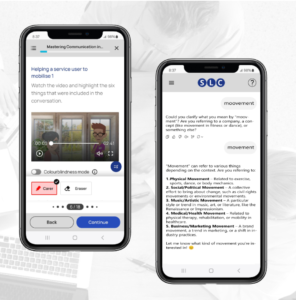
SLC win Ufi grant to develop AI language learning app for social carers
We’re delighted to have won a grant from Ufi VocTech Trust to develop an AI-driven technology solution that provides cheap phone-based language and communication skills

The Occupational English Test (OET) is a language proficiency test for healthcare professionals, designed to assess their ability to communicate effectively in English in a healthcare setting.
One of the four components of the OET is the Listening subtest, which assesses the test-taker’s ability to comprehend and respond to spoken English in a healthcare context.
In this article, we will discuss how to pass the OET Listening subtest by outlining strategies and self-study tips for each of the three parts of the Listening subtest.
Part A of the OET Listening subtest lasts for 15 minutes and requires the test-taker to complete notes based on a consultation between a healthcare professional and a patient.
Here are some strategies and self-study tips to improve your performance in Part A:
Part B of the OET Listening subtest lasts for 10 minutes and requires the test-taker to answer six multiple-choice questions based on six different extracts, which could be monologues or interactions.
Here are some strategies and self-study tips to improve your performance in Part B:
Part C of the OET Listening subtest lasts approximately 15 minutes and requires the test-taker to answer six multiple-choice questions based on two longer audios, which could be presentations or interviews.
Here are some strategies and self-study tips to improve your performance in Part C:
If you’re in need of additional assistance with your OET preparation, look no further than Specialist Language Courses (SLC), UK’s Leading Medical English Providers and OET Premium Preparation Provider.
With SLC, you can rest assured that you’re in good hands and on the right path to passing the OET test.
Check out SLC’s various courses to see which one would best suit your needs.
If you’re unsure which course is the ideal fit for you, don’t hesitate to reach out to SLC for guidance.
Contact information can be found here.
In conclusion, passing the OET Listening subtest requires a combination of effective strategies and to develop effective listening skills.
This can be achieved through various techniques such as using pre-listening time effectively, using transcripts during self-study, and listening to a variety of authentic audios to improve vocabulary and comprehension.
Building stamina is also crucial to perform well in the OET exam.
By incorporating these practices into your study routine, you can enhance your listening skills and increase your chances of success in the exam.
Remember, it takes time and effort to master any skill, but with dedication and perseverance, you can achieve your goals.

We’re delighted to have won a grant from Ufi VocTech Trust to develop an AI-driven technology solution that provides cheap phone-based language and communication skills

We’re delighted to announce a partnership with leading Medical English app, Doxa.

Back to Menu ↩ What is the UK Foundation Programme? The UK Foundation Programme is a two-year, structured, work-based training programme which is designed to
Get updates and get the latest materials on Medical English, OET and IELTS
